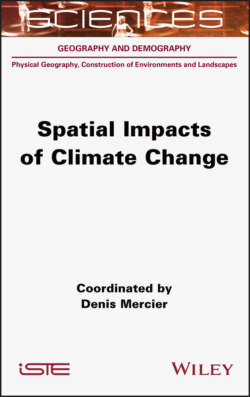Читать книгу Spatial Impacts of Climate Change - Denis Mercier - Страница 12
1.1. Contemporary global climate change
ОглавлениеContemporary climate change refers to the period from 1850 to the present day and covers the period from the Industrial Revolution to the digital revolution. It also covers a period during which humanity experienced a population explosion, reaching 1 billion people for the first time in 1820. On January 1, 2020, the human population was estimated at 7.7 billion and is expected to reach 11 billion by 2100, according to the UN.
Through the use of fossil fuels (coal, oil, gas) and increased agricultural production to feed the world’s growing population, these elements contribute to increasing humanity’s role in the climate machine.
Since the mid-19th Century, the average global air temperature has increased by 1.1 °C. This increase has not been linear over time and Figure 1.1 illustrates the stages of this evolution. Two warming sequences help to understand this increase: the first from 1910 to 1940 and the second from 1980 to the present day, during which the increase in temperature was 0.18°C per decade. According to the World Spatial Impacts of Climate Change, coordinated by Denis Mercier. © ISTE Ltd 2021.
Meteorological Organization1, the year 2019 was the second warmest year recorded since 1850. It comes after the year 2016, which experienced a particularly intense El Niño episode, with abnormally high ocean surface water temperatures in the eastern South Pacific. These two periods of warming are interspersed by temporal sequences of cooling (from 1880 to 1910, then from 1940 to 1980).
Figure 1.1. Annual mean surface temperature from 1880 to 2019 compared to the 1880-1920 mean
(source: Sato and Hansen, Climate Science, Awareness and Solutions at Columbia University Earth Institute, 2020). For a color version of this figure, see www.iste.co.uk/mercier/climate.zip
This non-linear temperature evolution over time is not spatially homogeneous (see Figure 1.2). These maps illustrate general trends. Continental land areas record this contemporary global warming better than ocean surfaces; of these continental land surfaces, those with a hypercontinental climate such as Siberia are experiencing the greatest temperature increases.
Although the map projection is not very favorable, Figure 1.2 shows that high latitude regions, especially the Arctic basin and its surroundings, have experienced the greatest increases in temperature.
Figure 1.2. Average surface temperature per decade from 1910 to 2017 compared to the 1951-1980 average. For a color version of this figure, see www.iste.co.uk/mercier/climate.zip
(source: 2018 NASA-GISS temperature data, downloaded from https://data.giss.nasa.gov/gistemp/)
Although the oceans are warming less than land areas, they are still warming and store 93% of the excess heat. The last 10 years are the warmest recorded for ocean surface waters since 1955 with a linearly increasing temperature trend since the 1980s (see Figure 1.3) (Cheng et al. 2020). For the first period, the warming was relatively constant of approximately 2.1 ± 0.5 Zetta Joules2 per year. However, the warming in the more recent period is greater than that of the previous warming (9.4 ± 0.2 Zetta Joules per year, or 0.58 watt per m2 on average on the Earth's surface), hence the significant increase in the rate of global climate change at the ocean scale (Cheng et al. 2020).
Figure 1.3. Ocean heat content (OHC) in the upper water section above 2,000 m from 1955 to 2019. For a color version of this figure, see www.iste.co.uk/mercier/climate.zip
COMMENT ON FIGURE 1.3.- The histogram represents annual anomalies (ZJ: Zetta Joules, where 1 ZJ = 1021 Joules) where positive anomalies relative to a mean calculated between 1981 and 2010 are shown as red bars and negative anomalies are shown in blue. The two dashed black lines represent linear trends for the periods 1955-1986 and 1987-2019 (source: Cheng et al. 2020).
The increase in ocean surface temperatures affects all oceans. Although some ocean areas, such as the North Atlantic, experienced a decrease in temperature between 1960 and 2019 (Cheng et al. 2020), the penetration of heat into the deep ocean is clear in Figure 1.4, mainly in the Atlantic and Southern oceans (Cheng et al. 2020). These two ocean basins, especially near the Antarctic Circumpolar Current (40° 60° S) show greater warming than most other basins (Cheng et al. 2020).
Figure 1.4. Vertical cross-section of ocean temperature trends from 1960 to 2019 from the sea surface to 2,000 m (60-year ordinary least squares linear trend). For a color version of this figure, see www.iste.co.uk/mercier/climate.zip
COMMENT ON FIGURE 1.4.- The zonal mid-sections of each ocean basin are organized around the Southern Ocean (south of 60° S) in the center. The black outlines show the associated mean temperature with 2°C intervals (in the Southern Ocean, 1°C intervals are shown as dashed lines) (source: Cheng et al. 2020).
This increase in global ocean surface temperatures leads, through thermal expansion, to a rise in sea level, as an increase in air temperature contributes to the melting of the Earth's cryosphere and thus to the increase in the amount of water in the global ocean (see Chapter 2 on melting of the cryosphere). Similarly, rising ocean temperatures reduce dissolved oxygen in the ocean and significantly affect marine life, especially corals and other organisms sensitive to temperature and water chemistry (IPCC 2019; see Chapter 4 on coasts). Increasing ocean surface water temperature promotes evaporation over the oceans and moisture in the atmosphere, which logically can promote heavy rainfall, and can be associated with more frequent and/or more intense cyclones, and can, depending on the case, lead to flooding (IPCC 2019). The consequence of this change in ocean temperatures is prolonged contemporary warming simply because of the thermal inertia of these gigantic ocean masses.
